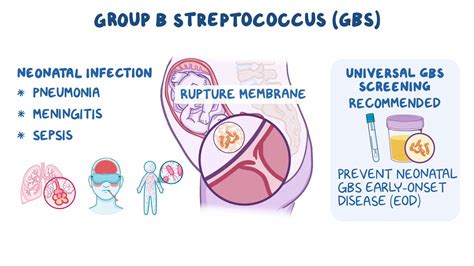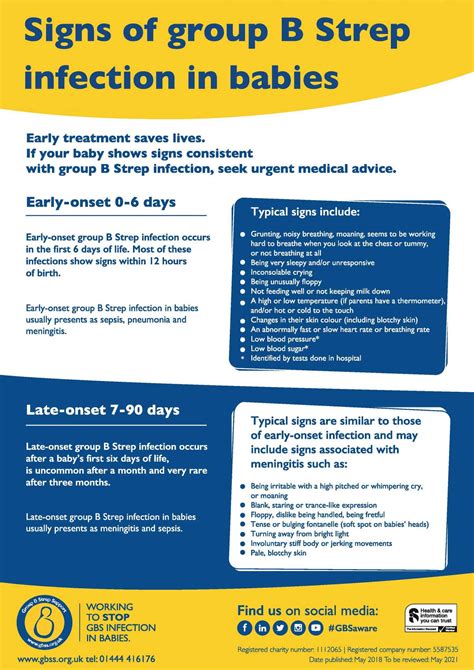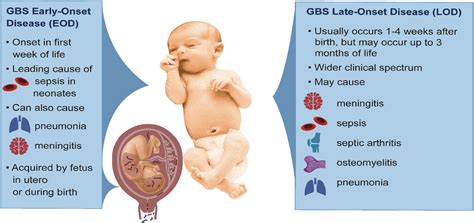Intro
Group B Streptococcus, also known as Group B Strep or GBS, is a type of bacterial infection that can be found in the digestive and urinary tracts of adults and children. While it is typically harmless in healthy individuals, GBS can pose a significant risk to pregnant women and their newborns. In recent years, there has been an increasing awareness of the importance of GBS testing and prevention, particularly among expectant mothers. As a result, it is essential to understand the causes, symptoms, and treatment options available for Group B Strep infections.
The importance of understanding Group B Streptococcus cannot be overstated, as it is a leading cause of illness and death among newborns. According to the Centers for Disease Control and Prevention (CDC), GBS is responsible for approximately 4,500 cases of neonatal sepsis and 440 deaths each year in the United States alone. Furthermore, GBS infections can also cause stillbirth, premature birth, and long-term health problems in affected infants. Therefore, it is crucial for pregnant women to be aware of the risks associated with GBS and take necessary precautions to prevent its transmission to their babies.
GBS infections can be particularly problematic for pregnant women, as they can increase the risk of preterm labor, miscarriage, and stillbirth. Additionally, women who test positive for GBS during pregnancy are more likely to experience complications during delivery, such as fever, chorioamnionitis, and endometritis. However, with proper testing, treatment, and preventive measures, the risk of GBS transmission can be significantly reduced. In this article, we will delve into the world of Group B Streptococcus, exploring its causes, symptoms, diagnosis, treatment, and prevention strategies, as well as the latest research and developments in the field.
What is Group B Streptococcus?

Types of Group B Streptococcus
There are ten different serotypes of GBS, which are classified based on their surface antigens. The most common serotypes are Ia, Ib, II, III, and V, which are responsible for the majority of GBS infections. Each serotype has its own unique characteristics, such as its ability to colonize the host, evade the immune system, and cause disease. Understanding the different serotypes of GBS is essential for developing effective prevention and treatment strategies.Causes and Risk Factors of Group B Streptococcus

Risk Factors for Group B Streptococcus in Pregnancy
Pregnant women who test positive for GBS are at a higher risk of transmitting the infection to their babies during delivery. The risk of transmission is increased in women who have a history of GBS infections, have a family history of GBS, or have had a previous baby with GBS infection. Other risk factors include preterm labor, premature rupture of membranes, and fever during labor. Understanding these risk factors is essential for healthcare providers to develop effective prevention and treatment strategies for GBS infections in pregnancy.Symptoms of Group B Streptococcus

Diagnosis of Group B Streptococcus
The diagnosis of GBS infections typically involves a combination of physical examination, medical history, and laboratory tests. In pregnant women, GBS testing is usually performed between 35 and 37 weeks of gestation using a vaginal and rectal swab. The swab is then sent to a laboratory for culture, which can take several days to produce results. In newborns, the diagnosis of GBS infections is typically made based on physical examination, medical history, and laboratory tests, such as blood cultures and PCR (polymerase chain reaction) tests.Treatment and Prevention of Group B Streptococcus

Prevention of Group B Streptococcus in Pregnancy
Preventing GBS infections in pregnancy is crucial to reducing the risk of transmission to the baby. Healthcare providers can take several steps to prevent GBS infections, including administering antibiotics during labor, performing GBS testing between 35 and 37 weeks of gestation, and educating pregnant women about the risks and symptoms of GBS infections. Pregnant women can also take steps to prevent GBS infections, such as practicing good hygiene, avoiding close contact with individuals who have GBS infections, and seeking medical attention immediately if they experience any symptoms of GBS infection.Complications of Group B Streptococcus

Long-term Effects of Group B Streptococcus
The long-term effects of GBS infections can be significant, particularly in newborns. Newborns who develop GBS infections are at a higher risk of developing long-term health problems, such as hearing loss, vision loss, and developmental delays. In some cases, GBS infections can also cause permanent damage to the brain, lungs, and other organs. Understanding the potential long-term effects of GBS infections is essential for healthcare providers to develop effective treatment and prevention strategies.Current Research and Developments in Group B Streptococcus

Future Directions in Group B Streptococcus Research
The future of GBS research is promising, with several new and innovative approaches being explored. One area of research focuses on the development of a GBS vaccine, which could potentially prevent GBS infections in pregnant women and newborns. Another area of research focuses on the use of probiotics and other natural remedies to prevent GBS infections. Additionally, researchers are exploring the use of gene editing technologies, such as CRISPR, to develop new and effective treatments for GBS infections.What is Group B Streptococcus?
+Group B Streptococcus is a type of bacterial infection that can be found in the digestive and urinary tracts of adults and children.
How is Group B Streptococcus transmitted?
+Group B Streptococcus can be transmitted through contact with contaminated food or water, or through close contact with an individual who has a GBS infection.
What are the symptoms of Group B Streptococcus?
+The symptoms of GBS infections can vary depending on the individual and the severity of the infection, but can include fever, chills, and uterine tenderness in pregnant women, and respiratory distress, lethargy, and feeding difficulties in newborns.
How is Group B Streptococcus diagnosed?
+The diagnosis of GBS infections typically involves a combination of physical examination, medical history, and laboratory tests, such as vaginal and rectal swabs, blood cultures, and PCR tests.
What is the treatment for Group B Streptococcus?
+The treatment of GBS infections typically involves antibiotics, such as penicillin or ampicillin, which are effective against the bacteria.
We hope this article has provided you with a comprehensive understanding of Group B Streptococcus, including its causes, symptoms, diagnosis, treatment, and prevention. If you have any further questions or concerns, please do not hesitate to reach out to your healthcare provider. Additionally, we encourage you to share this article with others who may be interested in learning more about GBS. By working together, we can raise awareness and reduce the risk of GBS infections, ultimately improving the health and well-being of pregnant women and newborns around the world.
